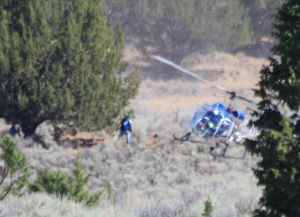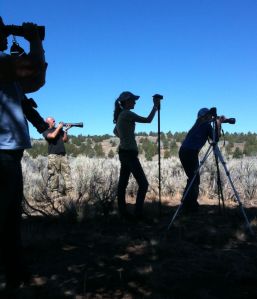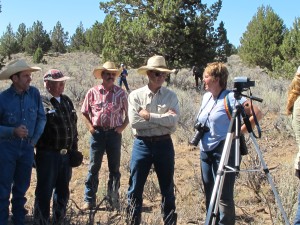(In My Humble Opinion) by R.T. Fitch ~ author of “Straight from the Horse’s Heart“
A Turning Point in Wild Horse Advocacy
It was a year ago today, September 7th, that myself, Terry, Ginger Kathrens, Makendra Silverman, Ann Evans, Pam and Tom Nickoles, Carol Walker, Elyse Gardner, Sandy Elmore and many others sat silently on a bluff overlooking the Britton Springs BLM Holding Facility in Wyoming and watched the cruel Cattoor Helicopter drive Cloud and his family into the awaiting holding pens.
I felt the world shift on its axis just a fraction of a degree, at that pivotal moment, and I can see the change in the magnetic field of wild horse advocacy at work one year later.
Last year I turned to our BLM Security escorts and told them that they had just messed up; they had captured the magnificent Cloud of whom every little girl has a model of on her dresser and tonight those little girls would be crying. And when the little girls cry the mothers are tense and when Mom is stressed Dad is pissed beyond all means and on that night, there were a lot of pissed off Dads across America. I thought that to be a big deal and would thereby culminate into the main impact of the BLM’s indiscriminate and unnecessary harassment of Cloud’s herd. But I was wrong; it runs much deeper than that.
Cloud’s abduction brought together a small handful of people that clung to one another and each brought to the roundup a special collection of talents and contacts. By using those contacts and the power of the internet a cross roads or tipping point was achieved and the issue of Wild Horse Advocacy was brought to a higher level of awareness not just across the United States but around the World in general.

Ginger Kathrens, Ben Sussman, Sandy Elmore, Terry Fitch, Pam Nickoles and Elyse Gardner ~ Photo by Tom Nickoles
One year later and have we made any difference in slowing down Ken Salazar and Bob Abbey’s voracious Wild Horse Harvesting Machine, the BLM? Not that one can see on the surface, but swimming against the current with great tenacity is a movement that is beginning to make the corrupt managers of insidious federal agencies a tad bit nervous. It’s only a matter of turning up the volume and keeping the pressure on the accelerator and sooner or later, someone with the authority will pull the plug on the BLM and its special interest driven calamity.
There is a part of me that wants to thank the BLM for their mismanaged mess that they called the Pryor Mountain gather of ’09. They tortured dozens of horses and tore many families apart but they did not kill any horses, that we know of. But above and beyond that, they brought us together and by behaving so recklessly and without scientific basis they galvanized an advocacy that is driven by truth, honesty and facts. If not for the careless stupidity of the BLM’s attack upon Cloud we might not have managed to pull together such a professional team of educated and dedicated advocates.
So I will, begrudgedly, tip the brim of my hat to the BLM for their own unprofessional behavior because due to their ego driven recklessness they managed to amplify something that Ginger Kathrens had been doing for years. They put a face and a name on the Wild Horse issue and turned “Cloud” into a household word across this nation. That’s worth millions in free publicity and to this day, the BLM does not have a clue as to how they played right into the hands of those who so vehemently oppose their broken policies.
They just don’t get it.
Click HERE for the thoughts and feelings that occurred one year ago, today.
Click HERE to read about the most recent attack upon Cloud’s life.














